Sub-Gigahertz Path Loss Measurement Campaign in Marine Environment: A Case Study
Abstract
:1. Introduction
2. Measurement Test-Bed
2.1. Antenna Design
2.2. Antenna System
2.3. Rf and Baseband Test Bed
2.4. Rf Power and Transmission Frequencies
2.5. Remarks about the Telemetry and Communication System
- Harvest raw data from sensors (connected through USB ports, and the i2c bus), e.g., GPS coordinates, angle w.r.t. magnetic north, wind speed, and angle;
- Compute meaningful and useful information from raw data;
- Provide a WiFi local area network (LAN);
- Publish the computed information through a socket service and a web application in the LAN;
- Send or receive coordinates and wind data via sub-GHz radios.
3. Radio Channel Analytical Description
3.1. Large-Scale Channel Model and Path Loss Exponent
4. Path Loss Measurement Campaign Results
5. Statistical Analysis of the Collected Data
6. Impact of Weather Conditions
7. Conclusions
Author Contributions
Funding
Institutional Review Board Statement
Informed Consent Statement
Data Availability Statement
Conflicts of Interest
Abbreviations
| ChP | Channel power |
| DP | Dew point |
| IL | Insertion loss |
| IoT | Internet of Things |
| ISM | Industrial, scientific, and medical bands |
| LAN | Local area network |
| LoS | Line of sight |
| OBW | Occupied bandwidth |
| PL | Path loss |
| PSD | Power spectral density |
| RF | Radio frequency |
| RH | Relative humidity |
| RL | Return loss |
| RM | Radio module |
| RSSI | Received signal strength intensity |
| SMA | SubMiniature version A connector |
| T | Temperature |
| TE | Transverse electric |
| TEM | Transverse electro-magnetic |
| TM | Transverse magnetic |
| UART | Universal asynchronous receiver-transmitter |
| VNA | Vector network analyzer |
Mathematical Symbols
| n | Path loss exponent |
| Zero-mean Gaussian random variable for modeling the path loss fluctuations | |
| Probability density function for the x ISM band, referring to the y-th outward () | |
| or return () route | |
| Transmitter and receiver antenna gain | |
| Variance of the path loss fluctuations, i.e., Gaussian random variable | |
| Variance of the path loss fluctuations for the x ISM band, referring to the y-th outward | |
| () or return () route | |
| Modeled path loss expressed in dB, as a function of the antennas’ distance | |
| Received power at the distance d | |
| Reference impedance for the IL and RL parameters |
Appendix A. A Focus On The Proposed Propagation Model
- The sea is totally flat and is regarded as a perfect electric reflector;
- The antenna on the transmitting boat is perpendicular to the sea;
- Also, the antenna on the receiving buoy is perpendicular to the sea.
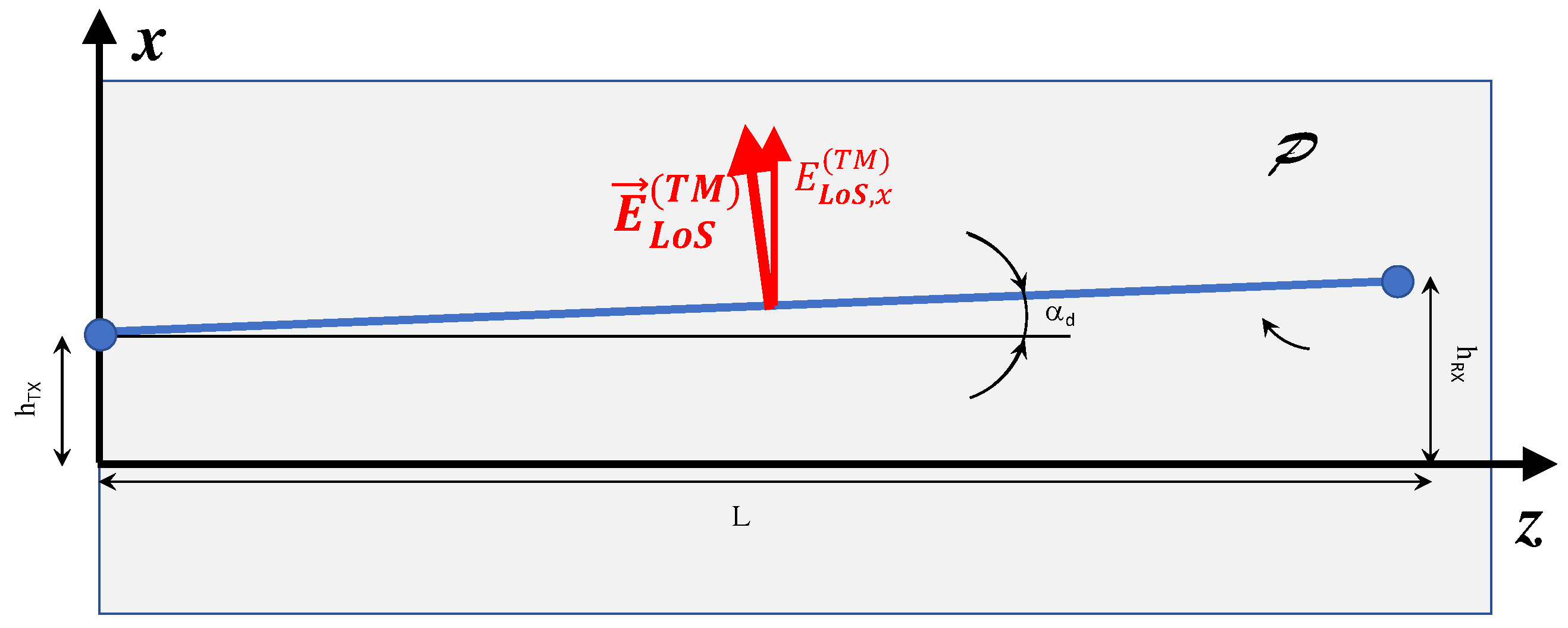


References
- Xu, G.; Shi, Y.; Sun, X.; Shen, W. Internet of Things in Marine Environment Monitoring: A Review. Sensors 2019, 19, 1711. [Google Scholar] [CrossRef] [PubMed]
- Huang, A.; Huang, M.; Shao, Z.; Zhang, X.; Wu, D.; Cao, C. A Practical Marine Wireless Sensor Network Monitoring System Based on LoRa and MQTT. In Proceedings of the 2019 IEEE 2nd International Conference on Electronics Technology (ICET), Chengdu, China, 10–13 May 2019; pp. 330–334. [Google Scholar] [CrossRef]
- Beshah, W.T.; Moorhead, J.; Dash, P.; Moorhead, R.J.; Herman, J.; Sankar, M.S.; Chesser, D.; Lowe, W.; Simmerman, J.; Turnage, G. IoT Based Real-Time Water Quality Monitoring and Visualization System Using an Autonomous Surface Vehicle. In Proceedings of the OCEANS 2021: San Diego–Porto, San Diego, CA, USA, 20–23 September 2021; pp. 1–4. [Google Scholar] [CrossRef]
- Ajith, J.B.; Manimegalai, R.; Ilayaraja, V. An IoT Based Smart Water Quality Monitoring System using Cloud. In Proceedings of the 2020 International Conference on Emerging Trends in Information Technology and Engineering (ic-ETITE), Vellore, India, 24–25 February 2020; pp. 1–7. [Google Scholar] [CrossRef]
- De Sanctis, M.; Cianca, E.; Araniti, G.; Bisio, I.; Prasad, R. Satellite communications supporting internet of remote things. IEEE Internet Things J. 2015, 3, 113–123. [Google Scholar] [CrossRef]
- Yang, Z.; Ghubaish, A.; Unal, D.; Jain, R. Factors Affecting the Performance of Sub-1 GHz IoT Wireless Networks. Wirel. Commun. Mob. Comput. 2021, 2021, 8870222. [Google Scholar] [CrossRef]
- Rappaport, T.S. Wireless Communications—Principles and Practice; Prentice Hall: Upper Saddle River, NJ, USA, 1996. [Google Scholar]
- Yee Hui, L.; Dong, F.; Meng, Y.S. Near sea-surface mobile radiowave propagation at 5 GHz: Measurements and modeling. Radioengineering 2014, 23, 824–830. [Google Scholar]
- Balanis, C.A. Antenna Theory: Analysis and Design; Wiley-Interscience: Hoboken, NJ, USA, 2005. [Google Scholar]
- Pozar, D.M. Microwave Engineering, 3rd ed.; Wiley: Hoboken, NJ, USA, 2005. [Google Scholar]
- Ansys HFSS. Finite Elements RF Simulator. Available online: https://www.ansys.com/products/electronics/ansys-hfss (accessed on 22 June 2022).
- Wurth Online. Wurth Elektronik. Available online: https://www.we-online.com/en/components/products/wco/ (accessed on 29 April 2022).
- ETSI EN 300 220-1 V3.1.1 (2017-02); Short Range Devices (SRD) Operating in the Frequency Range 25 MHz to 1000 MHz. ETSI: Sophia Antipolis, France, 2017.
- Scagnetto, I.; Brajnik, G.; Gus, P.; Trevisan, F. Oceanus: A context-aware low-cost navigation aid for yacht racing. J. Navig. 2021, 74, 738–749. [Google Scholar] [CrossRef]
- Barbiroli, M.; Fuschini, F.; Tartarini, G.; Corazza, G.E. Smart Metering Wireless Networks at 169 MHz. IEEE Access 2017, 5, 8357–8368. [Google Scholar] [CrossRef]
- Seidel, S.Y.; Rappaport, T.S. 914 MHz Path Loss Prediction Models for Indoor Wireless Communications in Multifloored Buildings. IEEE Trans. Antennas Propag. 1992, 40, 207–217. [Google Scholar] [CrossRef]
- Muñoz, J.; Mancipe, D.; Fernández, H.; Rubio, L.; Rodrigo Peñarrocha, V.M.; Reig, J. Path Loss Characterization in an Outdoor Corridor Environment for IoT-5G in a Smart Campus University at 850 MHz and 3.5 GHz Frequency Bands. Sensors 2023, 23, 9237. [Google Scholar] [CrossRef] [PubMed]
- Arpa FVG. Weather Stations. Available online: https://www.meteo.fvg.it/home.php (accessed on 22 June 2022).
- Calvert, J.G. Glossary of atmospheric chemistry terms (Recommendations 1990). Pure Appl. Chem. 1990, 62, 2167–2219. [Google Scholar] [CrossRef]

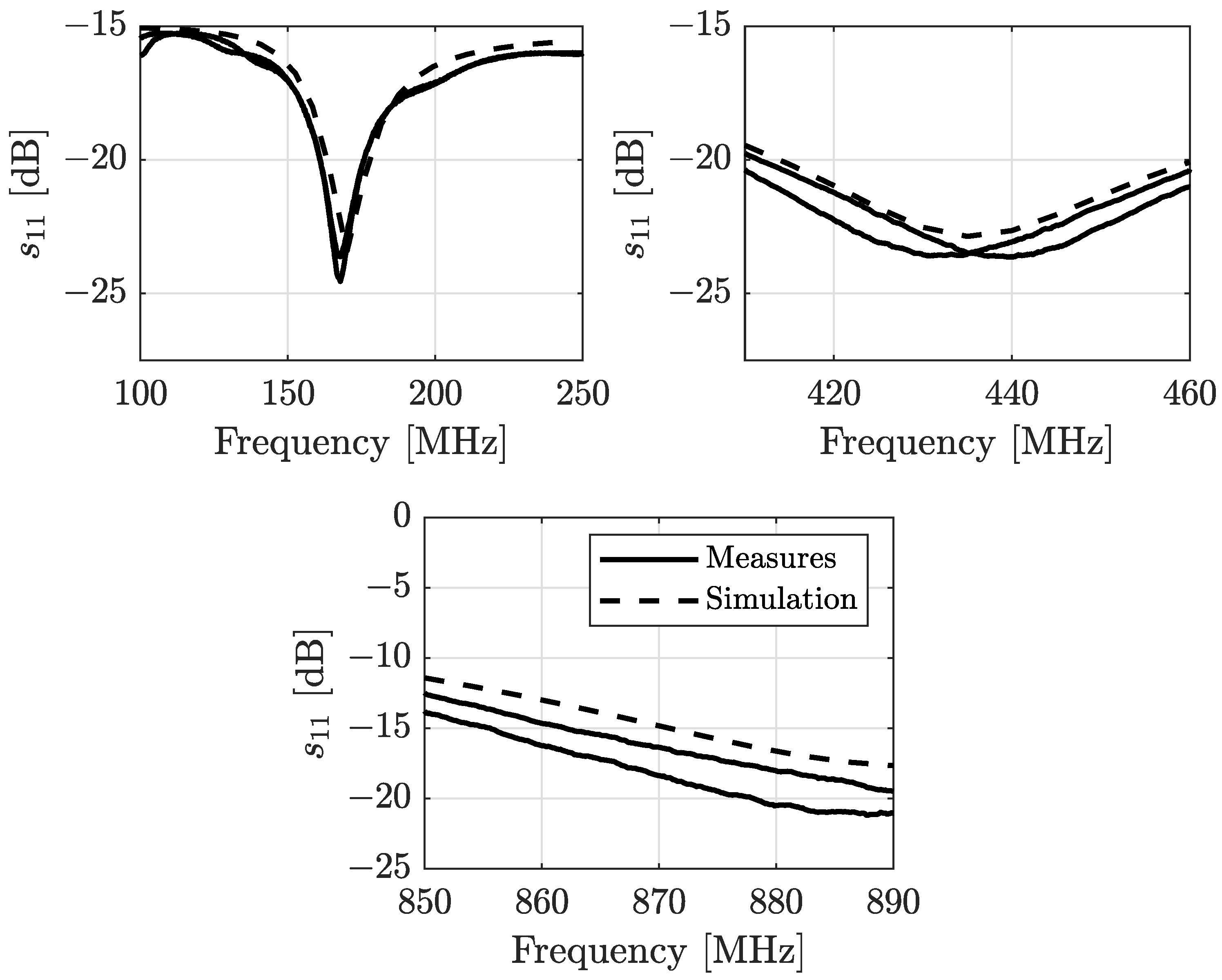






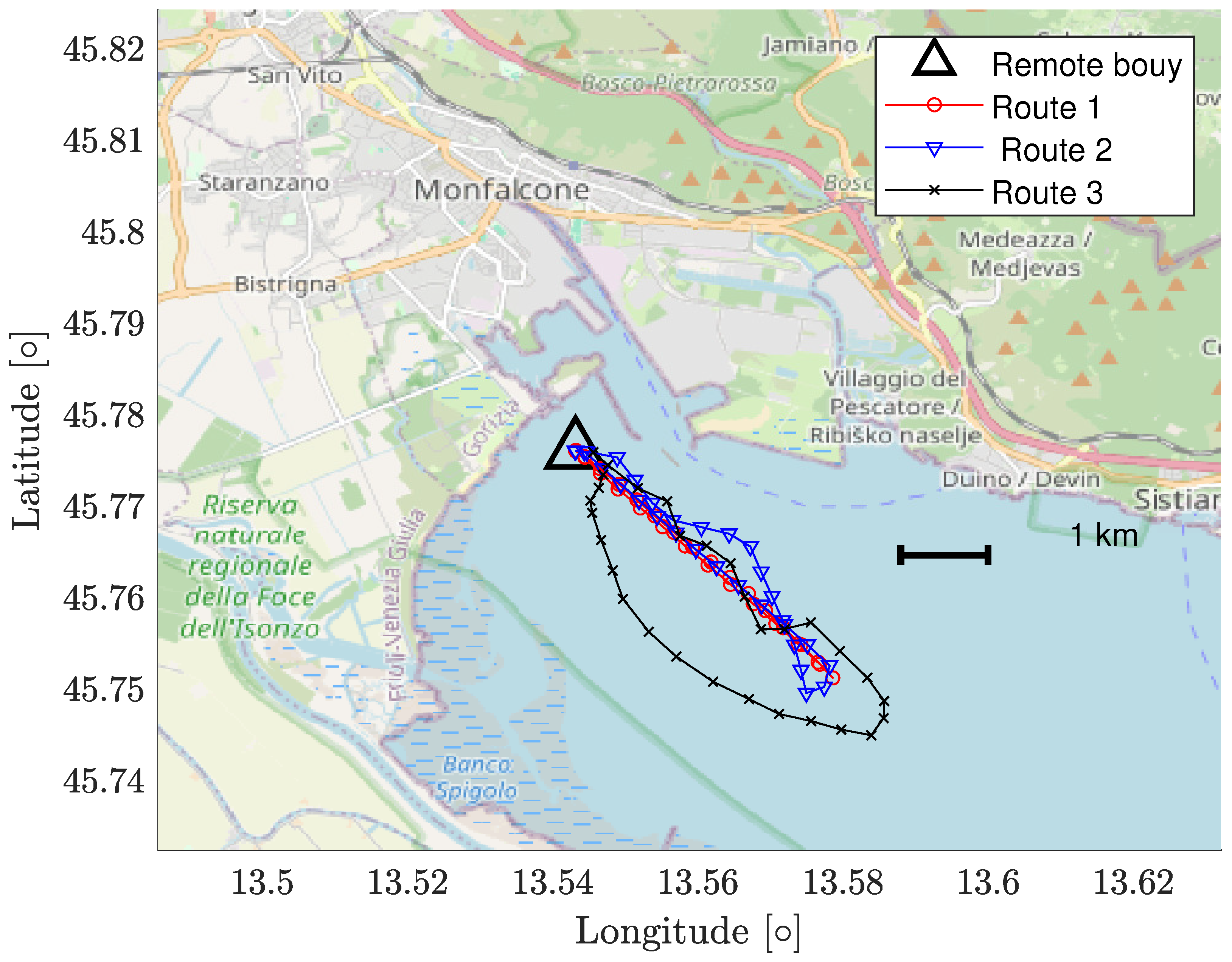
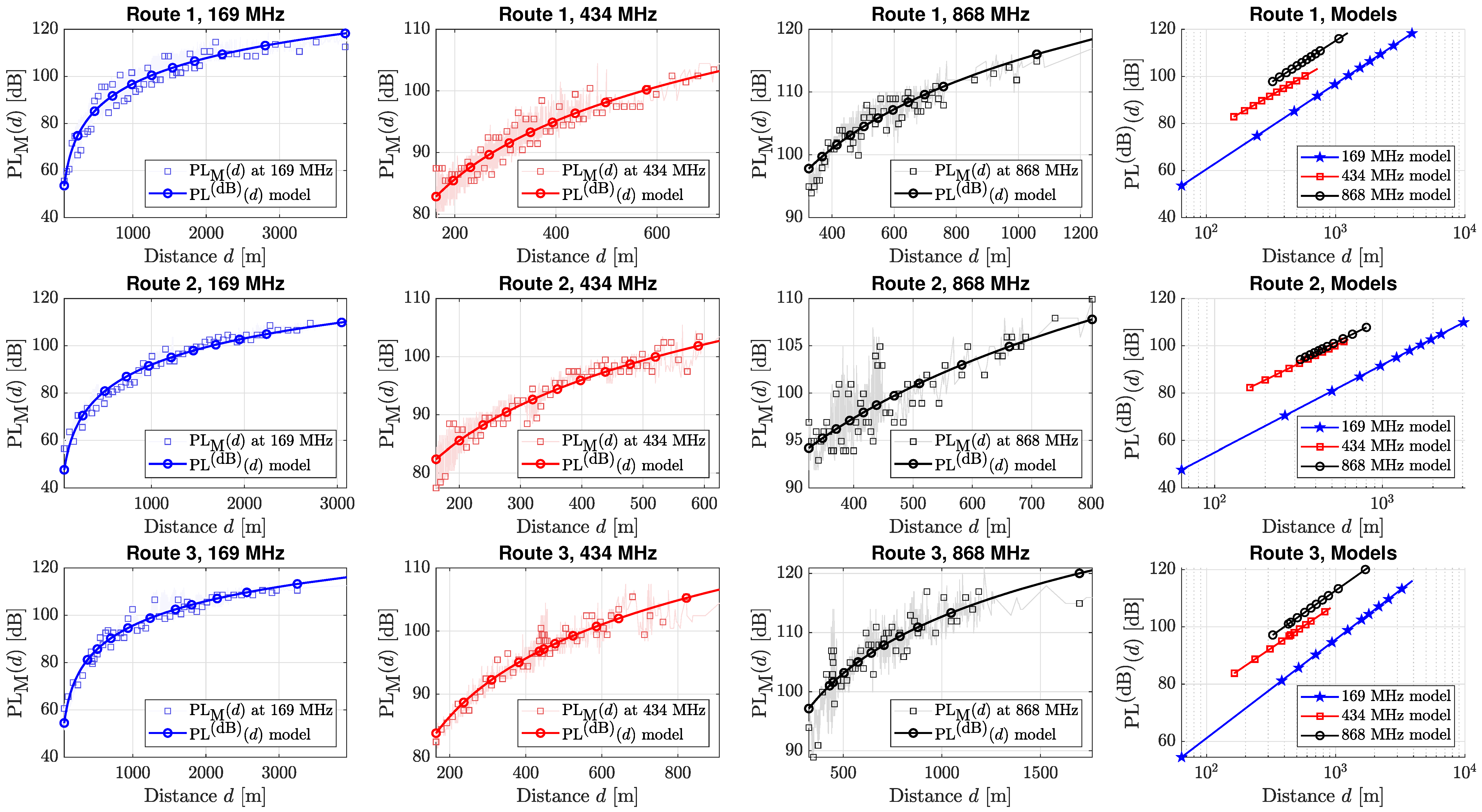


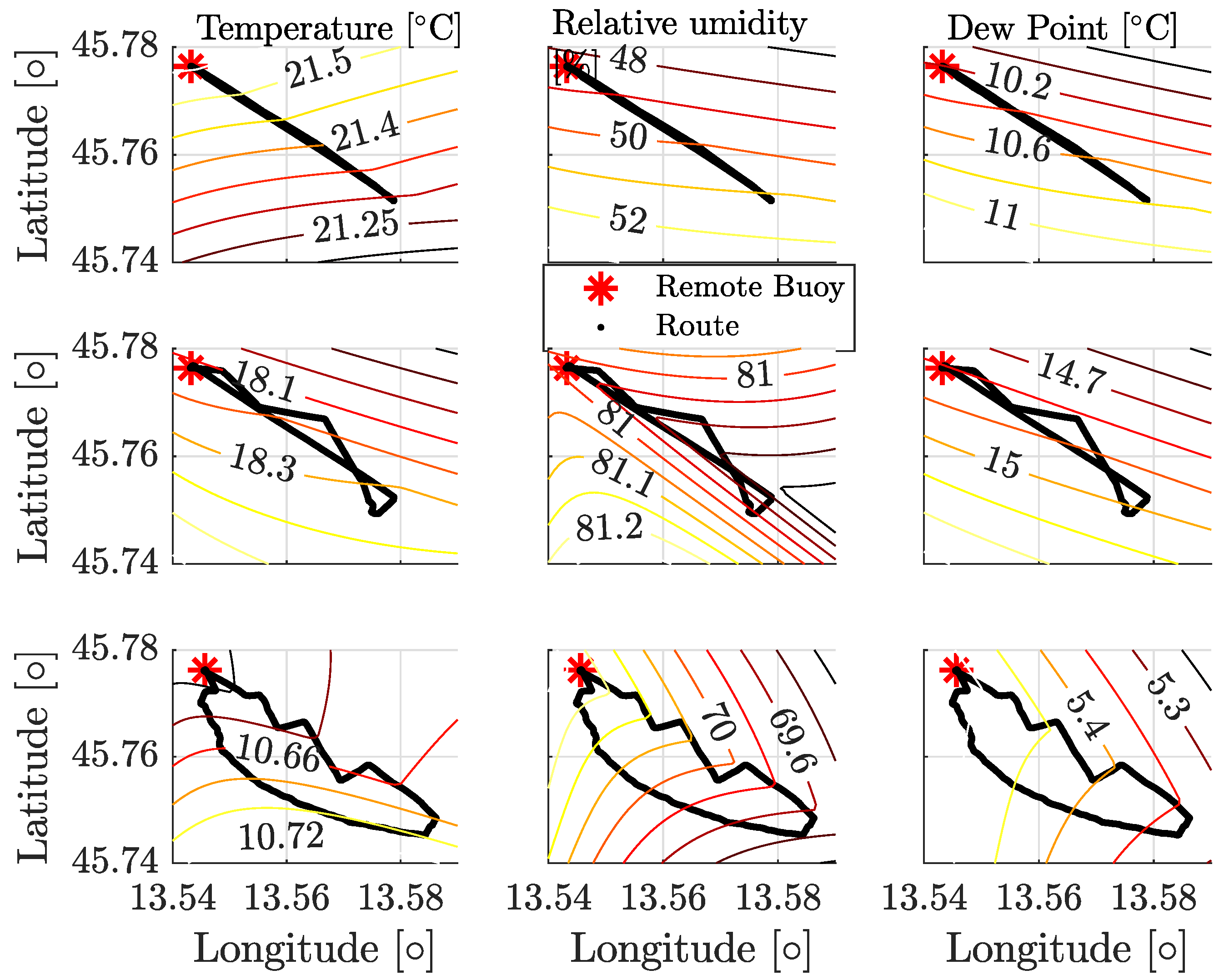
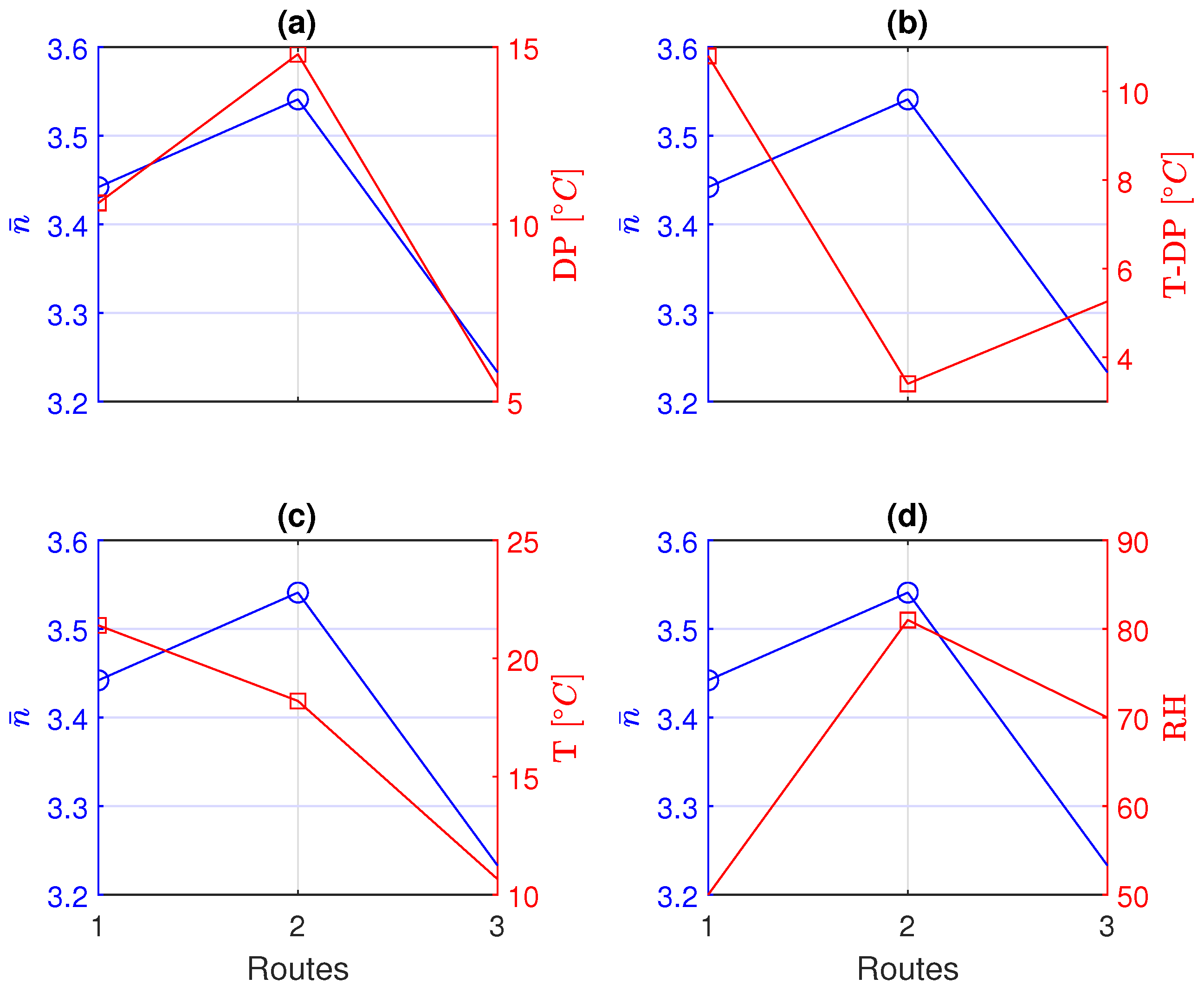
| Parameter | 169 MHz | 434 MHz | 868 MHz |
|---|---|---|---|
| ISM Band | ISM Band | ISM Band | |
| 2.32 dB | 2 dB | 2.03 dB | |
| 2.27 dB | 1.42 dB | 0.66 dB | |
| 2.37 dB | 2.75 dB | 3.43 dB |
| Parameter | 169 MHz | 434 MHz | 868 MHz |
|---|---|---|---|
| ISM Band | ISM Band | ISM Band | |
| Res. bandwidth | 300 Hz | 1 kHz | 1 kHz |
| Video bandwidth | 1 kHz | 3 kHz | 3 kHz |
| Frequency span | 600 kHz | 600 kHz | 600 kHz |
| OBW | 14.5 kHz | 78 kHz | 78 kHz |
| ChP | 14.1 dBm | 13.7 dBm | 13.8 dBm |
| Route | n at 169 MHz | n at 434 MHz | n at 868 MHz | |
|---|---|---|---|---|
| ISM Band | ISM Band | ISM Band | ||
| 1 | 3.629 | 3.146 | 3.551 | 3.442 |
| 2 | 3.699 | 3.695 | 3.455 | 3.541 |
| 3 | 3.447 | 3.223 | 3.189 | 3.233 |
| Route | at 169 MHz | at 434 MHz | at 868 MHz |
|---|---|---|---|
| ISM Band | ISM Band | ISM Band | |
| 1 | 17.55 | 5.171 | 3.845 |
| 2 | 9.157 | 3.956 | 6.365 |
| 3 | 8.111 | 3.400 | 8.543 |
| Route | |||
|---|---|---|---|
| ISM Band | ISM Band | ISM Band | |
| 1 outward | 1.97 | 0.67 | 3.07 |
| 1 return | 2.49 | 1.29 | 1.97 |
| 2 outward | 1.78 | 1.27 | 1.51 |
| 2 return | 6.26 | 2.43 | 6.12 |
| 3 outward | 1.76 | 1.14 | 3.79 |
| 3 return | 8.83 | 3.48 | 10.13 |
Disclaimer/Publisher’s Note: The statements, opinions and data contained in all publications are solely those of the individual author(s) and contributor(s) and not of MDPI and/or the editor(s). MDPI and/or the editor(s) disclaim responsibility for any injury to people or property resulting from any ideas, methods, instructions or products referred to in the content. |
© 2024 by the authors. Licensee MDPI, Basel, Switzerland. This article is an open access article distributed under the terms and conditions of the Creative Commons Attribution (CC BY) license (https://creativecommons.org/licenses/by/4.0/).
Share and Cite
De Piante, M.; Midrio, M.; Rinaldo, R.; Scagnetto, I.; Specogna, R.; Trevisan, F. Sub-Gigahertz Path Loss Measurement Campaign in Marine Environment: A Case Study. Sensors 2024, 24, 2582. https://doi.org/10.3390/s24082582
De Piante M, Midrio M, Rinaldo R, Scagnetto I, Specogna R, Trevisan F. Sub-Gigahertz Path Loss Measurement Campaign in Marine Environment: A Case Study. Sensors. 2024; 24(8):2582. https://doi.org/10.3390/s24082582
Chicago/Turabian StyleDe Piante, Marco, Michele Midrio, Roberto Rinaldo, Ivan Scagnetto, Ruben Specogna, and Francesco Trevisan. 2024. "Sub-Gigahertz Path Loss Measurement Campaign in Marine Environment: A Case Study" Sensors 24, no. 8: 2582. https://doi.org/10.3390/s24082582







